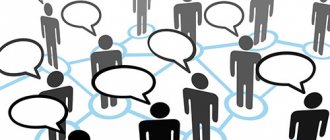Nonverbal is “body language” in a broad sense: the transmission of information through gestures, smells, taste, voice, visual signals. Nonverbal means of communication contribute to the creation of psychological contact between partners, enrich the meanings conveyed by words, and reflect the interpretation of the situation. Factors influencing the non-verbal side of communication are national characteristics, health status, professional etiquette, social status, and membership in certain age groups.
Means of nonverbal communication
Nonverbal communication what is it in psychology
Nonverbal communication is a type of communication without the use of words (through images, intonation, gestures, facial expressions). The tools for influencing a person are:
- sight;
- interpersonal space;
- optical-kinesthetic signals (facial expressions, appearance of the interlocutor, pantomime);
- peri-speech factors – vocal range, vocal qualities, timbre;
- extra-speech (laughter, speech rate, pauses).
For your information. Nonverbal methods of communication improve mutual understanding between people, allow you to predict the mood and attitude of the interlocutor towards the individual, and predict your own communication model.
Sight
The look is closely related to facial expressions. Eye contact is very important during a conversation. By the look of the interlocutor you can understand whether he is telling the truth or lying, whether he is interested in the conversation, whether he feels confident or embarrassed.
The more relaxed the conversation participants feel, the more often their views intersect. An interlocutor who hides his eyes does not inspire confidence. The pupils can also tell you a lot. Pupil dilation indicates that the person is in a good mood, excited, or interested in a conversation. Constriction of the pupils, on the contrary, indicates a bad mood.
The Origin of Nonverbal Communication
Perception - what is it in psychology
Nonverbal language has two types of origin: biological evolution and culture. Biologists have found that facial expressions when expressing emotions, most gestures and body movements in people are innate and serve as a signal for feedback. The biological nature of nonverbal communication is confirmed by elements not controlled subconsciously:
- paleness or redness;
- enlarged pupils;
- curvature of the lips;
- blinking.
Based on intentional and unintentional communication, there are 3 nonverbal means of communication:
- Behavioral factors. Caused by a physiological reaction: sweating from excitement, trembling in case of cold or fear.
- Unintentional means. Associated with people's habits (scratching temples, swinging legs, biting lips).
- Communication signals. Conveys brief information about an object, event, or state.
There are also universal signals known to everyone that are characteristic of a particular culture. Vivid examples are the style of behavior, dress code, and conventional signs of greeting and farewell.
Common “body signs”
How to learn sign language
You don't have to be an experienced psychologist to read body language. When talking, people give many almost imperceptible but significant signals that contain a lot of information. If you decide to learn how to “read” people, you need to know that the interpretation of body movements is influenced by the situation and the essence of the issue. Residents of different countries have different gestures and interpret them differently.
People who chew on pens and pencils need not worry. This is just a small bad habit.
Why is it important to understand body language? Once you become familiar with the body's signals, interpreting the information will become easy. Having basic knowledge and carefully observing a person, you can adjust your behavior to achieve your goals.
By understanding the psychology of gestures and nonverbal signs during a dialogue with a stranger, you can “read” his thoughts and understand how he perceived the information. Having knowledge in the field of the human subconscious and adjusting your behavior, you can always achieve the desired outcome.
From the video you will learn how to understand that a person likes you by body language signs
Communication nonverbal communication
Personality development - what is it in psychology
Nonverbal means of communication are a system of signs that complement, enhance or replace speech:
- Akulesika. Messages are conveyed through glances. They depend on the frequency and duration, intensity of contact (closely or sliding). The gaze reduces psychological distance or is perceived as a threat.
- Kinesics. Combines looks, facial expressions, postures, gestures, movements of sociocultural and physiological origin.
- Tactile behavior. The communication method is based on touch (ritual, love, professional, friendly) to strengthen or weaken communication processes.
- Chronemics. Use of time in nonverbal communication. For example, in the United States being late is considered disrespectful, but in Latin America this situation is common.
- Proxemics. Relationships are built taking into account distances and territorial locations.
- Sensory. The attitude towards an individual is based on perception by the senses (sensation of sound, taste, warmth of the interlocutor).
- Paraverbal communication is determined by vocal timbre, rhythm, and intonation when transmitting information.
Important! Specialists in nonverbal psychology combine the listed types of communication into various forms of information transmission: sign-symbolic, optical-kinetic, tactical and phonation (sound).
Her forms
Forms of verbal communication include oral and written speech, as well as such forms of interaction as monologue and dialogue. Depending on the development of events, oral speech may acquire the characteristics of a dialogue or monologue.
Forms of verbal communication include different types of dialogues:
- factual - exchange of information with the recipient for only one purpose - to support the conversation, sometimes this is perceived as a ritual (for example, when the question “how are you” does not involve listening to the answer);
- informational - an active process of information exchange, speech or discussion of any important topic;
- discussion - occurs when there is a contradiction in two or more points of view on the same problem, the purpose of such dialogue is to influence people to change their behavior;
- Confessional is a confidential type of dialogue that involves the expression of deep feelings and experiences.
Monologues in everyday life are not as common as dialogues. Verbal and nonverbal communication can be present in a monologue, when during a report or lecture a person not only provides information, but also accompanies it with facial expressions, gestures, a raised tone and changing intonation. In this case, both words and gestures become a specific code for the transmitted message. To effectively perceive these codes, it is necessary to understand them (it is difficult for a Russian person to understand a Chinese person, just as certain gestures are incomprehensible to the average person).
Types of nonverbal communication
Gestures
Placebo effect - what is it in psychology
Nonverbal gestures include pronounced movements of the head, hands, fingers, accompanying statements and thoughts. If people need to pay attention to objects, they will need the help of pointing gestures. Emphasizing gestures reinforce statements. A demonstrative movement of the brush explains the state of affairs. Touching a partner helps to establish social contact or receive a sign of attention, weakening the significance of information. Gestures are performed in voluntary and involuntary forms.
Pose
Postures must follow the rules of etiquette. Open poses of a sitting girl in Europe and America have neutral meanings; in Japan they are considered immoral. The squatting position of adults in most countries has an indecent definition; in South America and Africa, many peoples rest in a similar form. Using a chair is assessed as aggression.
Poses of strength and weakness
Postures during a public address or business conversation should express openness: arms unclasped, legs uncrossed, back straight. If you lean forward a little, your posture will be perceived as interest in an understandable topic. Slouching communicates uncertainty, while wide-set legs and arms indicate dominance. Tapping with a hand or foot is a manifestation of boredom, lack of time, impatience. The interlocutor took a closed posture - this may mean that the person does not believe or does not perceive the information well. The legs are turned towards the exit, the person wants to leave. The head is tilted forward, the interlocutor listens carefully and analyzes.
Facial expressions
Facial expressions are commonly called expressive movements of the facial muscles in order to express certain feelings of an individual. The types of facial expressions correspond to the functions of the psyche: mental acts are expressed by the muscles around the eyes, the perioral muscles are associated with acts of will. Feelings are emphasized by the general muscles of the face, changing in conscious and involuntary forms.
Various forms of facial complexes are possible:
- Amymia is the absence of visible facial changes.
- Tension can be indicated by a tight closure of the mouth and a petrified state of the upper part of the face.
- Interest can be easily recognized by a slight raising or lowering of the eyebrows, a slight widening and narrowing of the eyelids. The field of view increases, the focusing of the eyes becomes sharper.
- A smile can refer to calming or distracting from aggressive behavior, and is used when greeting.
Facial expressions convey basic emotions (joy, sadness, anger, surprise, disgust), provided by innate neural programs, as well as false information.
Facial display of emotions
Distance
The norms of approach between two people are defined in science by four intervals:
- Intimate. A length of 0...45 cm is considered optimal for communication between close people.
- Personal. A gap of 45...120 cm is maintained when communicating with familiar people.
- Social. A distance of 120...400 cm is recommended for official negotiations and conversations with strangers.
- Public. At a distance of 400...750 cm, it is not considered rude to exchange a couple of phrases; this interval is observed when speaking in front of an audience.
According to the teachings of social science, the rules vary for people of different ages, gender, and social status. For example, children and old people stay closer to their interlocutor, compared to teenagers. Men occupy distant positions, unlike women. A calm person gets as close as possible, an unbalanced person stays further. People address interlocutors of higher status at a great distance. Nationality also plays a role. Asians interact over shorter periods than Europeans, city dwellers are closer to settlers in sparsely populated areas.
Intonation
Prosody (voice tone, timbre, sound intensity, pauses) regulates the flow of speech, complements or replaces statements, and expresses the emotional state. It is important to be able to hear the intonation structure of speech, evaluate the strength and tone of voice, speed of speech, expressing the feelings and thoughts of the interlocutor:
- excitement is manifested by a low tone of voice, fast, abrupt speech;
- enthusiasm is demonstrated by a loud voice and clear, confident speech;
- fatigue can be easily determined by a low tone of voice, weakening of intonation towards the end of a sentence;
- signs of arrogance can be slow speech, even monotonous intonation;
- uncertainty is felt by interlocutors who make mistakes in words, frequent pauses, and nervous coughing.
The voice contains a lot of information about the owner. Experienced voice specialists are able to study the age, place of residence, character and temperament of the owner. People who have the ability to dramatically change the pitch of their voice are more sociable, more confident and pleasant than monotone or uncertain interlocutors.
Clothes speak about a person
Cloth
When forming an image, a person tries on a role in society and internal positions. The key characteristic is not fashion, but the style direction and color scheme. Extroverts rely on bright, rich colors. Introverts choose dark tones, nondescript, halftones, black, bed, beige, gray. Bright and large jewelry can also be a means of demonstrating a person’s egocentrism and high status (or the individual himself desires it).
Popular message topics
- Astronomy
“The Law of the Stars” is literally translated from the ancient Greek term “astronomy”. This science studies the structure of the entire surrounding component of the material world that is accessible to observation: the location and movement of processes - Celasia Flower
Definition of Celosia plant: Annual, up to 1 m tall, bare, branched stems, reddish in color. Petiolate leaf up to 3 cm long. The upper part is narrowed into a wedge shape. The inflorescence is dense and resembles a spikelet. - Discovery of Antarctica (Bellingshausen and Lazarev)
The very first person to suggest the existence of another continent in the frosty south was James Cook. But at that time, the difficult, cold, frosty situation did not allow him to confirm his assumptions in practice.
Features of nonverbal communication
Nonverbal communication is a situational reflection of people’s personal characteristics: mood, emotional background, attitude towards others and the topic. This communication is involuntary and spontaneous, it is difficult to divide it into individual elements (postures, facial expressions, olfactonics), this is the key feature of nonverbalism. Gestures, intonation, gaze are difficult to study or edit; it will take years and decades. But even trained people can be caught lying when one part of communication does not match another. Sign language is trusted more; it is perceived at the level of intuition.
Open posture in negotiations
Nonverbalism is an important element of communication, carrying 60-80% of information with the body, only 20-40% of communication is realized in words. It is worth closing your eyes and hiding your hands if you need to hide insincerity - this was the conclusion of one observant English court official.
Advice from psychologists: how to read body language and gestures
Even a very secretive person can read his thoughts and assess his emotional state using non-verbal communication. The science of gestures is accessible to anyone to study.
Where should I start? Psychologists have thoroughly studied body language and suggest starting with the following techniques:
- Note the movements that are made more often than others and compare them with words in conversation.
- Ask your opponent leading questions, asking again several times.
- Do not look at the person directly, so as not to arouse suspicion.
- If you discover a lie in a dialogue, do not talk about it, do not stop the conversation.
- Observe carefully, radiating positive emotions, learn to compare the information received.
Body and gesture language in psychology is not difficult to learn; the main thing is practice and a great desire to master the science. There is a lot of specialized literature for studying theoretical information.
To learn how to interpret the postures, facial expressions and gestures of different people, constantly train your ability to study emotional reactions, body movements, facial expressions and other non-verbal signals. Learn to distinguish symbolic gestures and compare signals.
Learn how to transform fears and phobias into friends and allies, because they attract unhappiness, destroy relationships, and hinder success and happiness. Change your life for the better with the help of the “Getting Rid of Fears” course.








